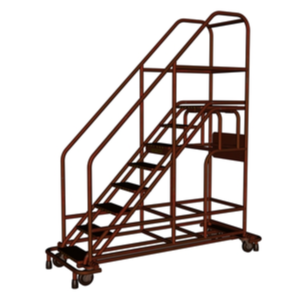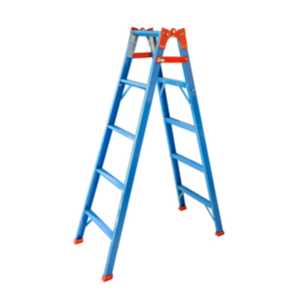As we’ve mentioned before on our blog, one in five lost work-day and fatal injuries are caused by ladder falls in general industry. This may be due to a lack of understanding about different ladders and how they work. Let’s go over the three most common types of OHSA ladders, as well as the benefits and ideal applications for each.
Three Main Types of OHSA Ladders
Industrial ladders are useful in many industries for numerous applications. They can be made from various materials like aluminum, wood, steel, and plastic. Aluminum ladders are popular because they are lightweight and are not affected by corrosion. Many industries opt for metal ladders due to their extreme durability. However, the material is not the only way to categorize these tools. So, what are the three main types of ladders? OSHA’s ladder standard covers the following:
- Portable Ladders
- Mobile Ladders
- Fixed Ladders
1. Portable Ladders
Portable ladders can be easily moved or carried compared to other ladder types. They feature side rails joined at intervals by rungs, steps, or cleats. They can either be self-supporting or non-self-supporting. OSHA requires employers to follow these standards regarding portable ladders:
- Minimum clear width of 11.5 inches
- Does not exceed the maximum intended load
- Must be used only on stable and level surfaces
- Must not be moved, shifted, or extended during use
- Top step and caps are not used as steps
Portable Ladder Applications
Because they are easily transportable, portable ladders are commonly used in a variety of industries. However, they are not known for bearing very heavy loads. OSHA encourages employers to use portable ladders equipped with safety features.
Portable Ladder Advantages
The greatest benefit of portable ladders is their ability to be stored easily. Depending on the size, you may be able to store your portable ladder in considerably small spaces. Employees can quickly take them in and out of storage as needed. This adds to the convenience factor, making them even more advantageous for busy work environments.
2. Mobile Ladders
A mobile ladder is defined by OSHA as a moveable, self-supporting, fixed-height ladder that has wheels or casters on a rigid base with steps leading to the top. They typically have handrails and are meant to be used by only one employee at a time. A mobile ladder stand platform is similar, with the addition of one or more standing platforms with means of access or egress. In order to avoid OSHA fines and penalties, employers must ensure that any mobile ladder in the workplace follows the following requirements:
- Has slip-resistant steps and platforms
- Does not move when an employee is on it
- Supports at least four times their maximum load
- Has a step width of at least 16 inches
- Has wheels or casters equipped with a system to prevent movement during use
- Has wheels or casters that can support four times the maximum load
- Stand and platform steps are uniformly spaced apart, with a rise ≤ 10 inches, depth ≥ 7 inches, and stair slope < 60 degrees
- Top step is protected on three sides by a handrail, midrail, and toeboard (or removable gates for special-use applications)
- The standing area is within the base frame

Mobile Ladder Applications
These ladder types are ideal for jobs that will take a relatively long time to complete. Their larger base makes them more comfortable for long-term tasks. Rail guards provide added caution, which can be beneficial in settings where fall protection safety is imperative.
Mobile Ladder Advantages
Transporting mobile ladders around the workplace is very easy. They can be rolled from one location to another with minimal effort, unlike conventional ladders. Workers are more productive when they don’t have to constantly take apart or put together equipment. Additionally, mobile ladders are designed to fit through congested areas or narrow passageways with easy maneuvering.
Another benefit of mobile ladders is how safe they are. They are far more stable than other ladder types, reducing falls and other workplace injuries. Since they don’t require a wall or structure to lean against, there is less risk of slipping and falling. Plus, mobile ladders feature safety railings and slip-resistant stairs.
3. Fixed Ladders
Fixed ladders are equipped with rails or individual rungs and are permanently attached to a structure. OSHA requires steps and rungs on these ladders to be coated with skid-resistant material to prevent slipping. Additional OSHA ladder safety rules and requirements include:
- Minimum clear width of 16 inches
- Must be used only for their designated purpose
- Must extend at least 42 inches above the access level
- Steps, rungs, and cleats must be spaced 10-14 inches apart along the rails
- Must be clean and free of obstructions at all times
- Safety devices required for ladders at least 24 feet in length
Fixed Ladder Applications
Fixed ladders are used in various industries to provide slip resistance, prevent corrosion, and even facilitate sanitation. Common applications that require fixed ladders include industrial facilities, wind turbines, telecommunications, crane installation, drilling rigs/platforms, and confined spaces.
Fixed Ladder Advantages
Fixed ladders are permanently mounted on a structure, and therefore, do not require assembly or transportation. They allow quick and easy access for inspection and maintenance work. Plus, if they are installed according to OSHA standards, they can improve your workplace’s safety ratings.
How to Choose the Right OHSA Ladder
Ladders are an everyday tool used in many industries. It’s important for employers to consider their options when purchasing new equipment for their operations. This will ultimately help protect the health and safety of all employees.
Every ladder is specifically designed to safely hold a set amount of weight. Before purchasing a ladder, take into consideration how much weight your jobs require. How much does your equipment weigh? What about your employees? Knowing these numbers will help you determine a maximum safe load capacity and find a ladder that meets your needs.
Contact Safety by Design for Fall Protection Training Services
Safety By Design offers OSHA fall protection training in Houston, Texas. Our programs can be specifically tailored to your organization to ensure the health and safety of all your employees. Don’t worry if you’re not up to date on OSHA ladder safety standards. Our safety compliance management specialists are here to help. Our team will identify problem areas in your processes and teach you how to improve your compliance for a safer and healthier work environment.
Contact us online today or call 832-304-5702 to learn about our Houston safety training options.
Tags: fall protection, ladder safety, OSHA standards, OSHA violations, safety training




